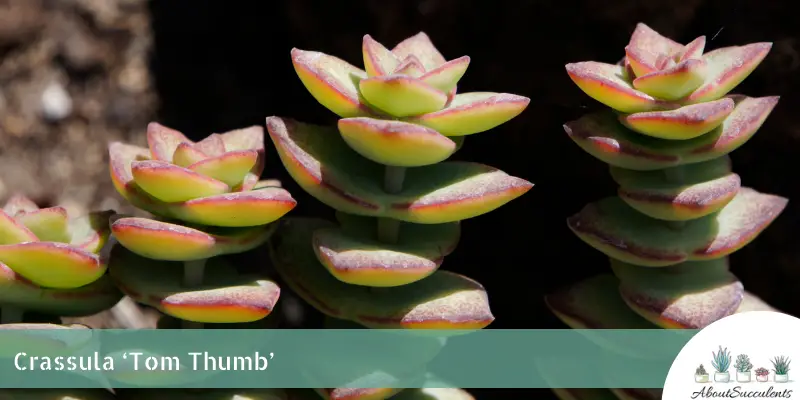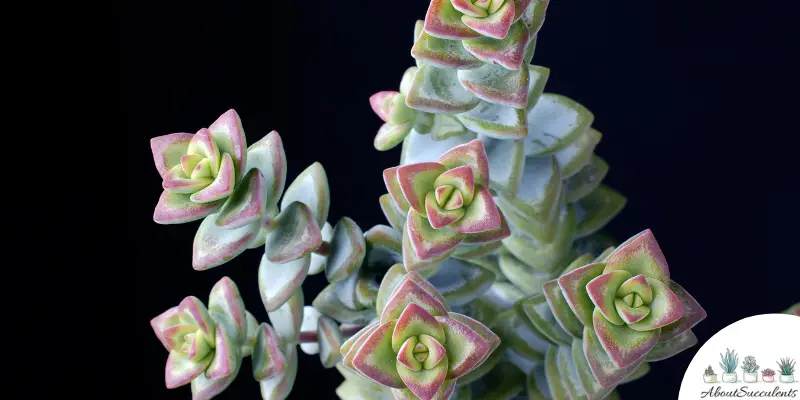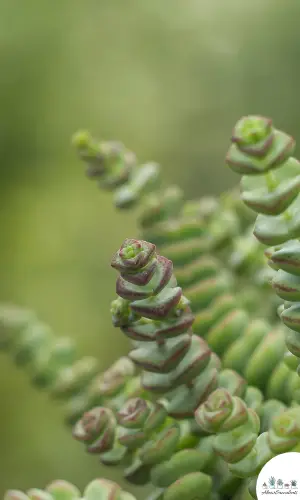
Crassula ‘Tom Thumb’ is an enchanting miniature succulent plant that’s often used as a filler for succulent gardens or as an accent to living wreaths. Fully-matured Tom Thumb will only reach a height of 15cm (6”).
This type of succulent is a hybrid of the Crassula rupestris marnieriana and the Crassula rupestris rupestris both of which are native to South Africa. Crassula ‘Tom Thumb’ is a member of the Crassulaceae family.
Crassula ‘Tom Thumb’ is also called Crassula ‘Klein Duimpje” has cylindrical-shaped stems that grow pairs of fleshy, triangular-shaped leaves on the opposite sides.
The foliage is light green in color that when exposed regularly to sunlight develops reddish-violet spots that add dynamic contrast to the green leaves.
In the springtime, Tom Thumb blossoms with clusters of small, white flowers that grow on its apex and are identified by 5 triangular petals which appear to open up backward.
General Information
Also known as: Tom Thumb or Klein Duimpje.
Plant Family: Crassulaceae
Origin: A hybrid of the Crassula rupestris marnieriana and the Crassula rupestris rupestris both of which are native to South Africa.
Height: 15cm (6”)
Exposure: Full to partial sunlight for up to 6 hours whether it’s grown outdoors or indoors.
Water Needs: Soak and dry method is recommended; only water the soil when it’s dry.
Soil Type: Organic, standard potting mix with perlite, pumice, or coarse sand added for improved drainage.
Soil pH: 6.0
How to Grow and Care for Crassula ‘Tom Thumb’

Crassula ‘Tom Thumb’ is an excellent first choice for beginning horticulturists and succulent hobbyists because it’s very easy to grow and care for.
This is a type of succulent that you don’t have to dote over. As long as Tom Thumb is located in an area that gets enough sunlight and it receives water whenever the soil has dried out, it will thrive.
It’s important to note that Crassula is not resilient to temperatures that drop below -1.1° C (30° F). If your region gets colder than this, it would be best to grow Tom Thumb in a pot that can be relocated inside your home.
Sunlight
Crassula ‘Tom Thumb’ does well in full or partial sunlight. It’s important to only expose your succulent to the rays of the morning or late afternoon sun. Look for a location in the garden where Crassula can get full to partial exposure up to 6 hours.
If you decide to move your plant indoors, place the pot near a window that gets up to 6 hours of partial sunlight every day.
You might want to consider buying a Grow Light if your area doesn’t consistently get a good amount of sunlight.
Watering

With Crassula ‘Tom Thumb’, you don’t have to worry about missing a watering schedule by a day or even by a week. Succulents do better with less water. Some varieties can go without water for a month.
To know for sure that it’s time to water Tom Thumb, all you have to do is check the soil’s level of moisture. You can use a Hygrometer to be sure but you can also get a good reading by inserting a stick an inch or two inside the topsoil.
If the stick comes up dry, water the soil until it’s completely soaked through. You’ll know if the soil has received enough water when the drain holes start to leak.
Remove the excess water from the drain tray. Keeping the roots of Crassula immersed in water can be fatal.
Pot and Soil
Crassula ‘Tom Thumb’ is popularly grown in a pot because it enhances the adorableness of the succulent. Yes, you need a good-looking pot but more importantly, you need a pot that helps release moisture from the soil.
- Choose an unglazed pot that’s made of ceramic or terracotta. Unglazed pots allow excess moisture to escape along their sides.
- Make sure the pot has drain holes at the bottom. A better choice is one that has drain holes and a mesh net cover to keep excess soil from coming out.
The ideal soil for Tom Thumb is one that’s well-draining such as organic standard potting mix with added ingredients like perlite, pumice, or coarse sand to improve drainage.
How to Propagate Crassula ‘Tom Thumb’
One reason why succulent growers love Tom Thumb is that it’s easy to propagate and the plant grows fast.
Method 1 – Offsets
Step 1: Pull out the offsets that are growing near the base of the plant. You can also cut them off with a sterilized pair of gardening scissors.
Step 2: Allow the offsets to dry out and develop calluses. This process might take 2 to 3 days.
Step 3: Plant the offsets in well-draining soil and keep it lightly moist until the roots have formed.
Step 4: Once the roots have firmed up, water the soil only when it’s completely dry.
Method 2 – Leaves
Step 1: Perform a “twist and pull” on a healthy leaf from a stem closest to the main plant. Make sure that no part of the leaf is left on the stem to ensure a successful propagation. You can also use a sterilized pair of scissors or a knife.
Step 2: Leave the cuttings in a dry area for up to 3 days so they can develop calluses.
Step 3: Place the cuttings on a pot of organic soil mix and keep it moist until the roots have taken hold.
Step 4: When the roots have taken hold in the soil, follow the soak and dry method and only give water if the soil is 100% dry.
Frequently Asked Questions
Is Crassula ‘Tom Thumb’ Toxic to Cats and Dogs?
Crassula ‘Tom Thumb’ is safe for pets as it’s not included in the website of the American Society for the Prevention of Cruelty to Animals (ASPCA) list of plants that’s toxic to cats and dogs.
Why Is My Crassula ‘Tom Thumb’ Dying?
If you suspect that your Crassula ‘Tom Thumb’ is on the verge of dying – don’t panic. You can still revive the succulent if you act right away. The culprits could be overwatering or pest infestation.
Overwatering
Typical of many succulent plants, Crassula ‘Tom Thumb’ should only be watered when the soil is 100% dry. If the roots remain in moist soil for a long time, they will rot and be exposed to developing a fungal infection.
When infection sets in, the fungus can spread very fast and work its way inside the plant. You’ll know for sure that Tom Thumb is infected if you notice signs of discoloration on its leaves and stems.
Grab a pair of sterilized garden scissors or a knife and cut off the discolored sections of the plant. To ensure that there will be no further infection, remove Crassula from its soil and cut off the rotted roots.
Replant Crassula in a new pot filled with fresh, well-draining soil. If you move fast, you can still enjoy many wonderful years with Tom Thumb.
Pest Infestation
Similar to other succulent varieties, Tom Thumb is no stranger to pests.
Mealybugs help themselves to the Crassula’s sap while mollusks enjoy the plant’s edges.
Remove these pests before they cause further damage by spraying Tom Thumb with neem oil or any organic insecticide.
Wipe off all strange, white substances on the leaves that could lead to a fungal infection with a cotton ball soaked in 70% isopropyl alcohol.
Does Crassula ‘Tom Thumb’ Produce Flowers?
Yes, Crassula ‘Tom Thumb’ produces clusters of tiny white flowers in the spring.
Last Updated on June 9, 2022 by Sofia Lara